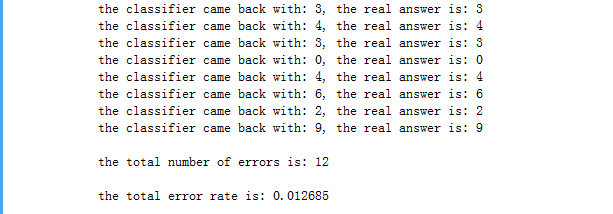1 from numpy import * 2 import matplotlib 3 from os import listdir 4 import kNN 5 def img2vector(filename): 6 returnVect = zeros((1,1024)) 7 fr = open(filename) 8 for i in range(32): 9 lineStr = fr.readline() 10 for j in range(32): 11 returnVect[0,32*i+j] = int(lineStr[j]) 12 return returnVect 13 def handwritingClassTest(): 14 hwLabels = [] 15 trainingFileList = listdir('trainingDigits') #load the training set 16 m = len(trainingFileList) 17 trainingMat = zeros((m,1024)) 18 for i in range(m): 19 fileNameStr = trainingFileList[i] 20 fileStr = fileNameStr.split('.')[0] #take off .txt 0_0.txt 将整个文件名以 . 分开 取第一部分也就是0_0 21 classNumStr = int(fileStr.split('_')[0]) #将 0_0 以 _ 分开 取第一部分也就是0 22 hwLabels.append(classNumStr) 23 trainingMat[i,:] = img2vector('trainingDigits/%s' % fileNameStr) 24 testFileList = listdir('testDigits') #iterate through the test set 25 errorCount = 0.0 26 mTest = len(testFileList) 27 for i in range(mTest): 28 fileNameStr = testFileList[i] 29 fileStr = fileNameStr.split('.')[0] #take off .txt 30 classNumStr = int(fileStr.split('_')[0]) 31 vectorUnderTest = img2vector('testDigits/%s' % fileNameStr) 32 classifierResult = kNN.classify0(vectorUnderTest, trainingMat, hwLabels, 3) 33 print "the classifier came back with: %d, the real answer is: %d" % (classifierResult, classNumStr) 34 if (classifierResult != classNumStr): errorCount += 1.0 35 print " the total number of errors is: %d" % errorCount 36 print " the total error rate is: %f" % (errorCount/float(mTest)) 37 handwritingClassTest()

